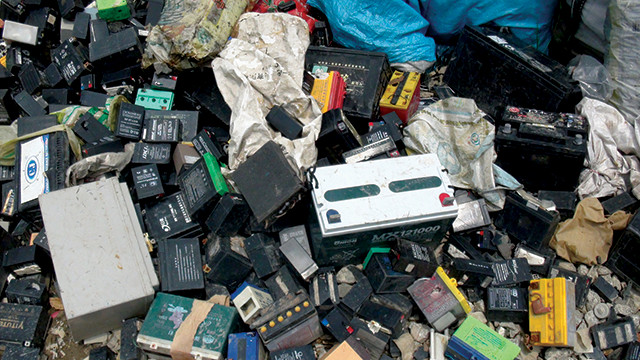
by Mary Caperton Morton Tuesday, April 10, 2018

Lead-acid batteries — used to power motor vehicles and cellphone towers, and for power storage at wind and solar farms — are one of the most recyclable products, but they are also highly toxic. Credit: baselactionnetwork, CC BY-ND 2.0.
Of all the recycling industries in the world, lead-acid battery recycling is one of the most profitable — and one of the most toxic. In the U.S., regulations on the industry have dramatically reduced lead exposure and pollution at battery recycling plants. But in Africa, where the industry is growing and largely unregulated, lead levels are skyrocketing. A new study in Environmental Research looking at environmental lead levels in seven African countries is shining a spotlight on the ongoing public health crisis.
Last year, the medical journal The Lancet published a report on pollution and health that showed that pollution contributes to more deaths worldwide than anything else. Lead poisoning alone is estimated to kill between 1.5 million and 2 million people worldwide each year, many of them children who are more susceptible to its insidious neurological effects.
“If you look at the global lead poisoning epidemic, the lead car battery recycling industry is one of the main culprits,” says study lead author Perry Gottesfeld, executive director of Occupational Knowledge International, a nonprofit focused on public health issues related to industrial pollution. Car batteries, which are typically replaced every few years, account for the vast majority of the lead-acid batteries recycled; cellphone towers, solar and wind power farms, and computer server farms also rely on rechargeable lead-acid batteries. “Lead car batteries are one of the most recyclable products in the world. You can make a whole new battery from recycling an old one. It’s quite economically profitable,” says Gottesfeld.
But few low- and middle-income countries have regulations in place to enforce pollution and exposure controls. “In the U.S., recycling plants have made major improvements in recent decades to meet the emissions standards imposed by the Clean Air Act,” Gottesfeld says. These improvements include sealing plants to reduce emissions, monitoring ambient air quality and tracking blood lead levels in workers. Steps as simple as showering before going home can greatly reduce lead transport by plant workers into their homes.
“We have the technology to make this a relatively clean industry. It’s even economically feasible, but in many places the industry just isn’t regulated,” Gottesfeld says. In formal recycling plants in Africa, he says, pollution controls are “lacking in all ways, in terms of occupational exposure to workers and their families, and in the emissions from these plants.” A lack of automation in some plants means that workers spend their days dismantling old batteries with axes to remove the lead. There are also “people melting down lead batteries right outside their homes to sell the scrap.” In total, Africa produces more than 800,000 tons of lead from recycled batteries each year.
Few studies have documented lead levels around battery recycling plants in Africa. Gottesfeld and his colleagues collected soil samples from bare ground inside 15 recycling plants in Cameroon, Ghana, Kenya, Mozambique, Nigeria, Tanzania and Tunisia, as well as within a half-kilometer radius outside the plants. They found lead levels as high as 140,000 milligrams per kilogram (mg/kg), with averages of about 57,700 mg/kg inside the plants and 2,600 mg/kg outside, far surpassing the U.S. Environmental Protection Agency’s soil hazard level of 1,200 mg/kg (or 400 mg/kg in “children’s play areas”).
Blood lead levels of workers in African battery recycling plants, and their families, have also not been documented in detail, in part because many African countries lack sufficient laboratory facilities to process the samples, Gottesfeld says. The U.S. Centers for Disease Control and Prevention (CDC) estimates that blood lead levels among children generally rise by 3 to 7 micrograms per deciliter (g/dl) for each increase of 1,000 mg/kg of lead in soil. Both the CDC and the World Health Organization recommend action be taken when blood lead levels are over 10 µg/dl in adults or 5 µg/dl in children, although no amount of lead in the blood is considered safe, Gottesfeld says.
“In low-income countries, there is very little awareness about the toxicity of lead at all levels,” says Richard Fuller, an engineer with Pure Earth, an international nonprofit that identifies and remediates polluted sites around the world. “When we measure blood lead in these places, it’s not unusual to see levels over 40 or 50 [µg/dl],” he says, which is high enough to cause convulsions, permanent brain damage, kidney failure, heart failure and death.
“Studies like this are important for highlighting the global burden of lead poisoning,” says Fuller, who was not involved in the work. “Lead poisoning affects on the order of half a billion people worldwide, but there is very little awareness or funding to solve this issue.” However, regulations on recycling plants have helped where they’ve been enacted, such as in Vietnam, where “we saw average blood lead levels of 45 [µg/dl] go down to 8 within about a year.” Solving the issue in the seven African countries highlighted in the new study will require “a country by country and city by city approach to force, ask or cajole the formal plants to improve their facilities, and to educate people about the dangers of informal recycling practices,” he says.
Gottesfeld and his colleagues plan to conduct more environmental toxicity studies around recycling plants and also to measure blood lead levels in workers, their families and communities near recycling plants. “It’s important to remember this isn’t some marginal industry,” Gottesfeld says. “It’s an industry that operates profitably and at a large scale.”
© 2008-2021. All rights reserved. Any copying, redistribution or retransmission of any of the contents of this service without the expressed written permission of the American Geosciences Institute is expressly prohibited. Click here for all copyright requests.